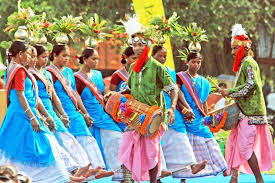Sarhul Festival:

The Sarhul Festival, celebrated by adivasi communities in Jharkhand and the Chhotanagpur region, marks the arrival of spring and the new year.
- Sarhul means “worship of the Sal tree” and signifies the union of the Sun and the Earth, which is essential for life.
- The Sal tree is considered sacred, believed to be the abode of Sarna Maa, the village deity.
- Three-Day Festival:
- Day 1 – Preparations begin, with homes and Sarna Sthals cleaned, Sal flowers gathered, and the village priest (pahan) observing a strict fast.
- Day 2 – Main rituals are performed at Sarna Sthals (Sacred Groves), including sacrifices, prayers for prosperity, and cultural performances.
- Day 3 – Concludes with a community feast, featuring Handia (rice beer), ceremonial fishing, and traditional adivasi cuisine.
- The festival is celebrated by several tribes, including the Oraon, Munda, Santal, Khadia, and Ho.
- Anthropologist Sarat Chandra Roy (1928) noted that Sarhul evolved from a hunting-based ritual to an agricultural festival, reflecting changes in adivasi life.
- Due to historical migration, Sarhul is now celebrated in Assam, Andaman and Nicobar Islands, Nepal, Bangladesh, and Bhutan.




